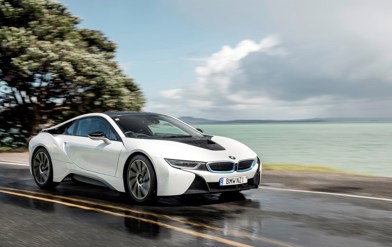Tesla’s entry-level Model 3 was the poster child for battery electric vehicles (BEVs) in New Zealand last year. Fuelled (ha ha) partly by the cult-like status of the brand and partly by the government’s Clean Car Discount for sub-$80k BEVs, it cracked the top-10 sales list for 2021. More Kiwis purchased the Model 3 than the Mazda CX-5.
Given the Model 3 (below, left) is a slightly unfashionable sedan, you’d have to think the just-launched Model Y (below, right) is potential gold. It’s based on the Model 3, just slightly taller, quite a bit more spacious and a whole lot more like an SUV.

Our test vehicle is the entry-level standard-range (60kWh battery) RWD: the one most people will buy.
This entry variant is not available in some markets, including the US and UK, which have the 75kWh battery and dual-motor AWD as standard. But it’s an ideal specification for NZ and that Clean Car Discount: the price of $76,200 leaves room for Tesla’s alarming $1375 “delivery fee” and questionable $400 “order fee”, taking your invoice total to $77,975 - meaning you can claim the government $8625 BEV rebate.
Our evaluation car wears Midnight Silver paint ($1700, white is the only free colour) and very sharp 20-inch Induction alloys ($3300). So all-up it’s $83,243, underlining how you have to think carefully about how much options are really costing you.
A dual-motor Performance AWD version of the Model Y is on the way, with 0-100km/h in 3.7 seconds. That’s supercar fast, but the Clean Car situation also means the real-world difference between this $108,900 machine and the RWD is $43,325. So you also have to think about how much it’s costing to go that quickly in your family SUV.
The RWD Y commands a $3000 premium over the equivalent Model 3 and you’re getting rather a lot for that. It’s 180mm taller, with significantly higher H-points for occupants and vastly more luggage space: 847 litres for the Y versus 525l for the 3. The rear seatbacks can folded from the boot for a whopping total of 2158l; the loadspace is flat enough to be properly useful, too (if not totally flat).
Is it really an SUV? We can argue that all day (one might ask whether SUVs should, by definition, have high ground clearance), but it’s obvious the midi-people-mover Y body shape, weird though it is, aligns much more closely with what Kiwis want than the 3. There’s also a bit of trickle-down status from the Model X, which is very much the flagship/aspirational Tesla family car and has a similarly bulbous profile. No “Falcon” rear doors for the Y, though (Tesla did show an early concept with them).
The Y cabin architecture is virtually identical to the 3, with every display and control running through a centrally mounted 15-inch touch screen; that includes Tesla Arcade games and streaming services for when you’re parked/charging, plus “caraoke” for passengers when you’re driving. Gulp.
You have to admire the commitment to the concept and the menus are intuitive, but you also have to question the wisdom of needing to go into the screen for a simple adjustment of the side mirrors, vents or to open the glovebox.
But some of the tech integration is genius. You get a slender keycard, but you can use your phone instead: the car will recognise your mobile when you approach and unlock, allow you to drive away with one touch of the gear selector and lock automatically again as you walk away. There are dual wireless chargers in the centre console too; nice touch, although the screens of both device are worryingly visible from the driver’s seat.
The controversially named Autopilot driver-assistance package continues. Yes, it is still very good. No, it doesn’t do anything other cars with Level 2 tech can’t, despite the weird Tesla-fan mythology that surrounds it. In fact, it’s overly sensitive in adaptive cruise mode; you have to keep your hands on the steering wheel to keep it active, but only the lightest touch is required. The slightest pressure on the steering and Autopilot cancels immediately.
The Model 3 brought great handling to the Tesla brand, so it’s a good base for the Model Y to work from. In fact, the low centre of gravity that’s endemic to BEVs means you’re losing little in dynamic character with this taller car.
The RWD Y is brisk but not strikingly fast. What’s impressive is the linearity of the acceleration, even in the sportier of the two settings.
The entry 3 has a compliant ride (much more so than the Performance version), although our test Y’s optional 20-inch wheels introduced a bit of low-speed thump on urban roads.
The chassis is accomplished and the steering substantial, although you could argue the steering wheel is trying too hard to be sporty by being too thick. The chassis is no less composed at speed, but the steering is not as assured over Kiwi backroads as it is in city driving. Less rim thickness, more communication, please Tesla.
If you’re a passenger coming out of the 3 to the Y, it will be a revelation. The higher seating immediately improves visibility, but also the range of adjustment you can employ for ultimate comfort. It’s brilliant in the back, adjustable rake with loads of leg and head (one advantage of that egg-shaped roof) room. It’s a great way to travel.
The Model Y completes Elon Musk’s well-publicised ambition to create a “SE3Y” range of cars. Which is a shame, because it makes your eyes roll so much it hurts; but the rest of the car is really quite an impressive SUV(ish) BEV.
TESLA MODEL Y RWD
ENGINE: 60kWh battery with single electric motor
POWER: 220kW/420Nm
GEARBOX: Single-speed automatic, RWD
CONSUMPTION: 13.2kWh/100km (WLTP)
PRICE: $76,200





